Archive Gallery | RIBA President Simon Allford @ WDCC
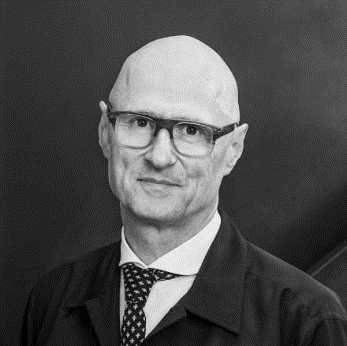
Simon Allford
RIBA President, Executive Director of AHMM Architecture Studio
From AHMM’s base in London Simon leads a studio that works in the UK and internationally, engaging public and private clients in the exploration of a particular architecture’s potential to offer delight as well as utility. Simon works on a wide range of scales and typologies. Simon engages in the broader architectural discussion as a writer, critic, teacher, judge of competitions, frequent lecturer, examiner, advisor and commentator.
Simon is a Trustee of the London School of Architecture and has been chairman of the Architecture Foundation, a trustee of the Architecture Association Foundation, and a visiting professor at The Bartlett and Harvard Graduate School of Design. He has previously been Vice President for Education at the RIBA and a Chair of Design Review at CABE, and is a judge for the RIBA Awards. In September 2021 he began his two-year term as President of the Royal Institute of British Architects.
Invited and curated by RUAN Xing, Dean and Guangqi Chair Professor of Architecture, Shanghai Jiao Tong School of Design, Simon Allford was invited to be an expert of the Creative City Network of Shanghai Think Tank. He attended the World Design Cities Conference on 16 September and share his views on Construction the Idea.
(The text is organized by Wang Hao, Assistant Prof. of Architecture, Shanghai Jiao Tong School of Design)
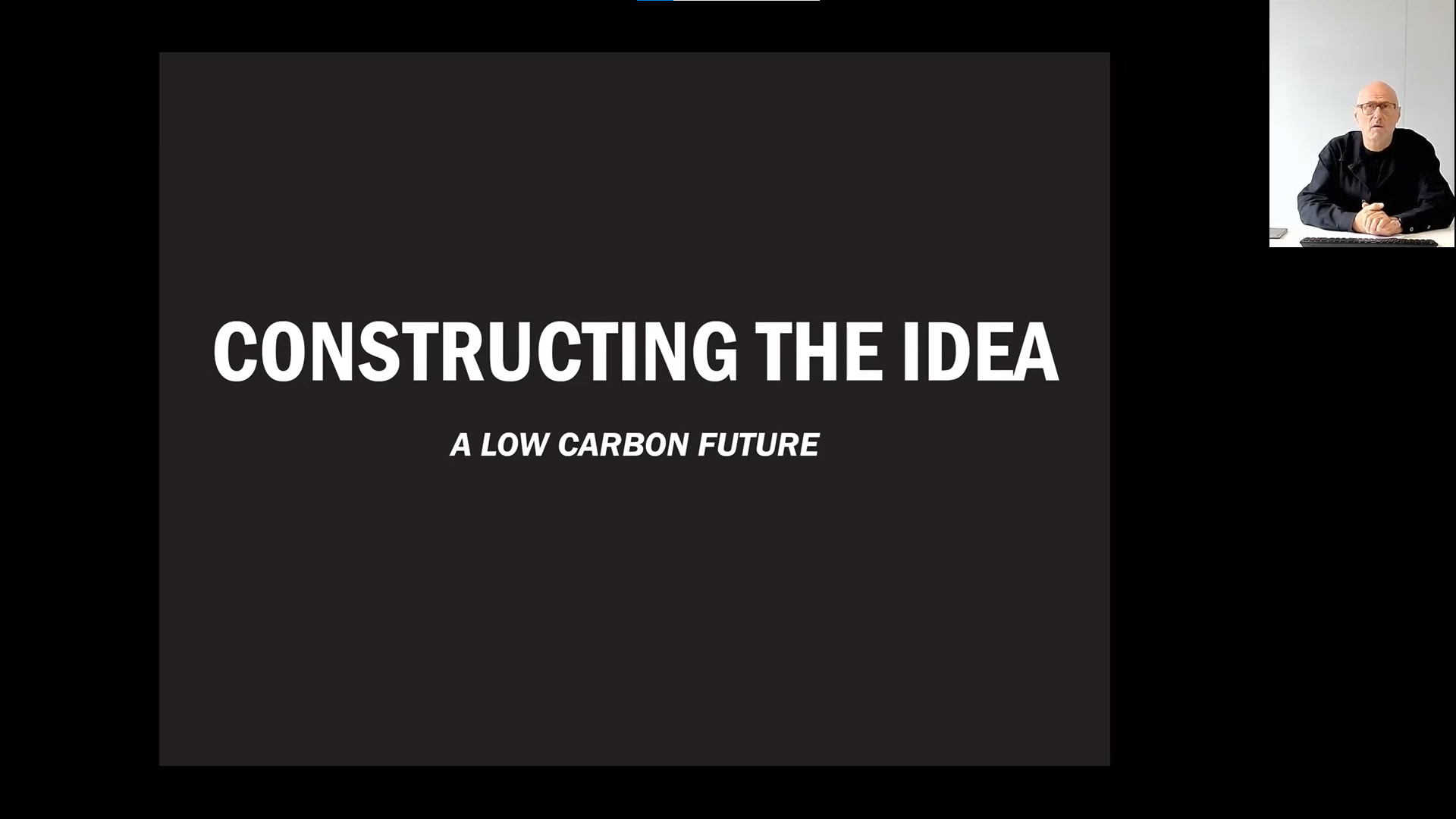
I’m delighted to be part of Creative City Network and a member of the Shanghai Think Tank. My brief talk will be about architecture and the city. The title Constructing The Idea is my thinking about how we collaboratively helped lead the low carbon future that is so essential.
I believe climate challenge is the greatest threat we face, but also perhaps the greatest creative constraint and that architecture and design are embracing. That challenge will be liberated to reinvent itself for the 21st century, we are looking at rethinking and reworking cities. Cities are established for hundreds and thousands of years. Of course, there’s been incredible growth of cities no more than anywhere else in China, but the idea of this talk will really focus on the endless rebuilding of our world.
This is an image by Joseph Gandy of the works of John Soane, we are often played it as a proto modernist. But it is an imaginary city constructed of his buildings, and in a sense, it captures that tension that exists between the creative design of the individual building and the greater project of the city. Those boundaries will be increasingly blurred and designing an infrastructure of streets or metro systems or a more basic level, sewage, can completely reinvent a relationship of the populace, the people with the city. The benefits we have in reconstruction of city like London or Shanghai, is you are working with layers of history.

Public and Private Buildings by Joseph Gandy
As a young student, and with my colleagues now my partners who produce this drawing generic city. It was really just thinking about architecture in the scale of the city grid. It was an idea based on modulars, a Broadway boogie woogie blues. The idea is about density, and the central idea of smaller plots in the center, larger plots at the edge. The creative city often being built of the incidents that you find in a layered historic city. Historic city is a collage, a palimpsest.

Generic city drawings by Simon Allford et al.
The things that we talked about first is in the field of everyday building rather than public building that modern architecture has failed the city. We have always been interested in the impact of housing, schools, factories, offices and relationships of those individual buildings to the city and to each other is a defining characteristic of a place.
Second is the end of the twentieth century dispute that functional program alone is not sufficient to generate an architecture. We are all aware of form follows function and that many witty place upon that phrase ever since, but in essence my conclusion is that we are designing buildings and cities for the future we do not know. What is the essential program of the building, the program of the city to allow creative forces, to emerge and take ownership of the places that we help construct.
Cities have been challenged, this is an image from the 1990s talking about the early ideas of the international global productivity that there will be a diaspora of people living away from cities. In fact, actually more people have moved to cities. Cities are the best mechanisms for bringing people together.
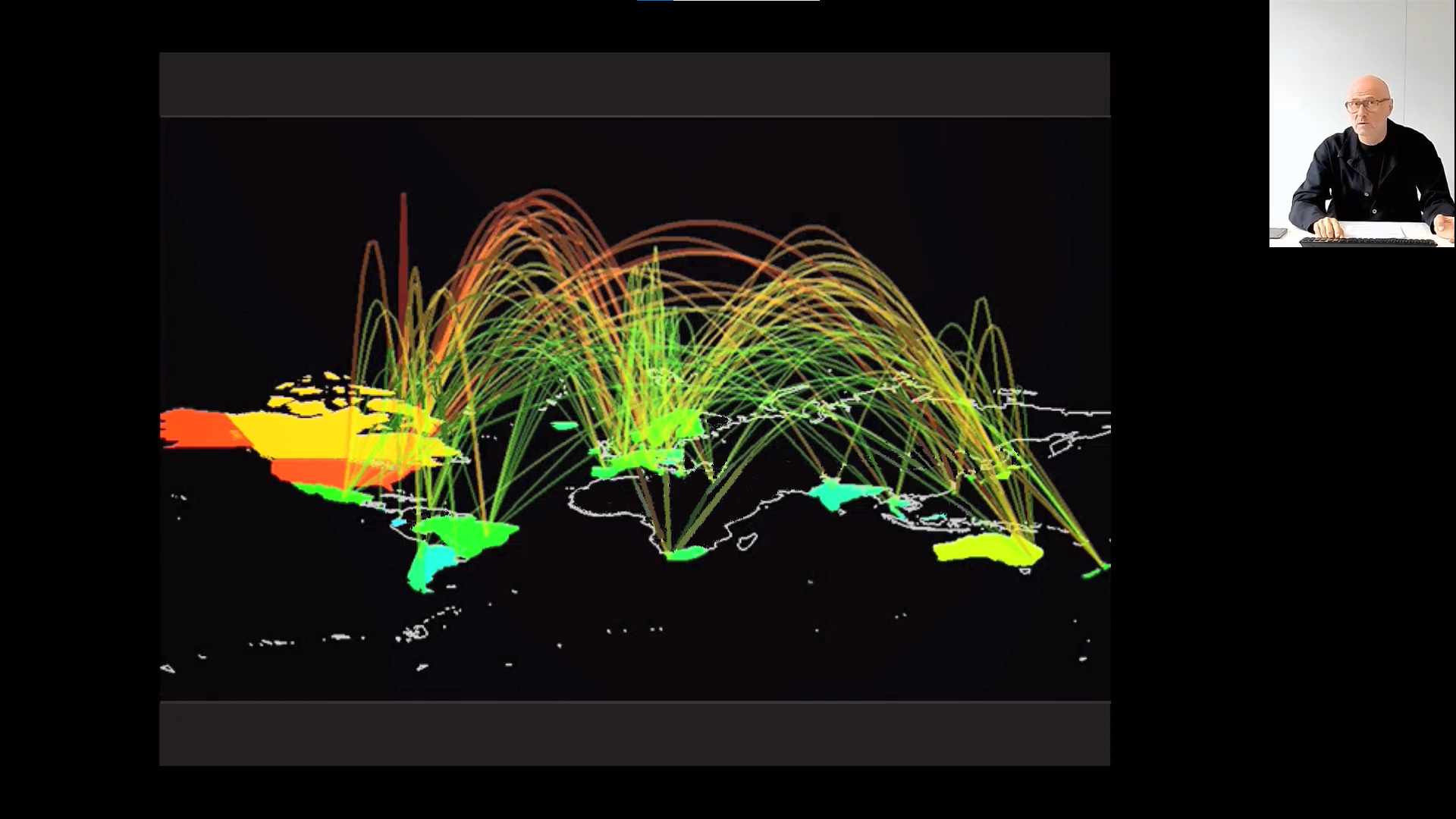
Early ideas of the international global productivity in 1990s
This is an image from the 1960s by the French filmmaker Jacquens Tati, but it could be the post Covid world, as an image of segregation. Much is made of the impact of hybrid working and living on the city, whereas in fact the Covid proved the essential import of meeting people and socializing. I believe cities will be enriched by the hybrid conversation. Cities might grow in their scale, maybe not physically, but in their connectivity with more people from distance able to engage with and benefit from them. But still physical social contact today, is the greatest driver of creativity, and in cities you can create that formally but also informally in a way that social media and other networks fail to successfully mimic.
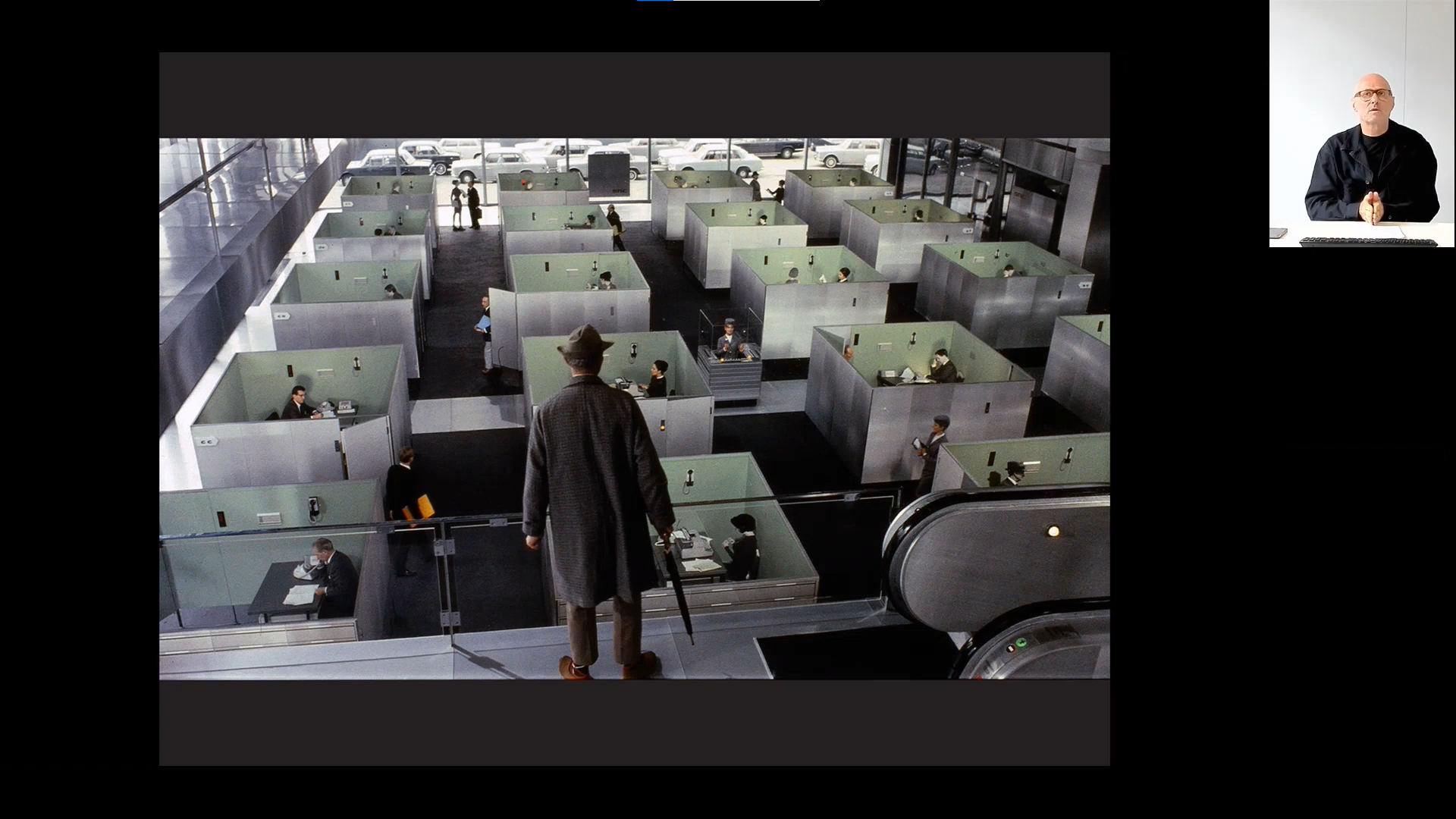
Playtime directed by Jacquens Tati
This is the Nolli plan of Rome shows the idea of the urban palimpsest. The city built upon the city, and in essence we are pursuing the same model in history. Moving a road is a much bigger event than moving a building. Cities carry history and memory, and that is something we can all react and creatively respond to.
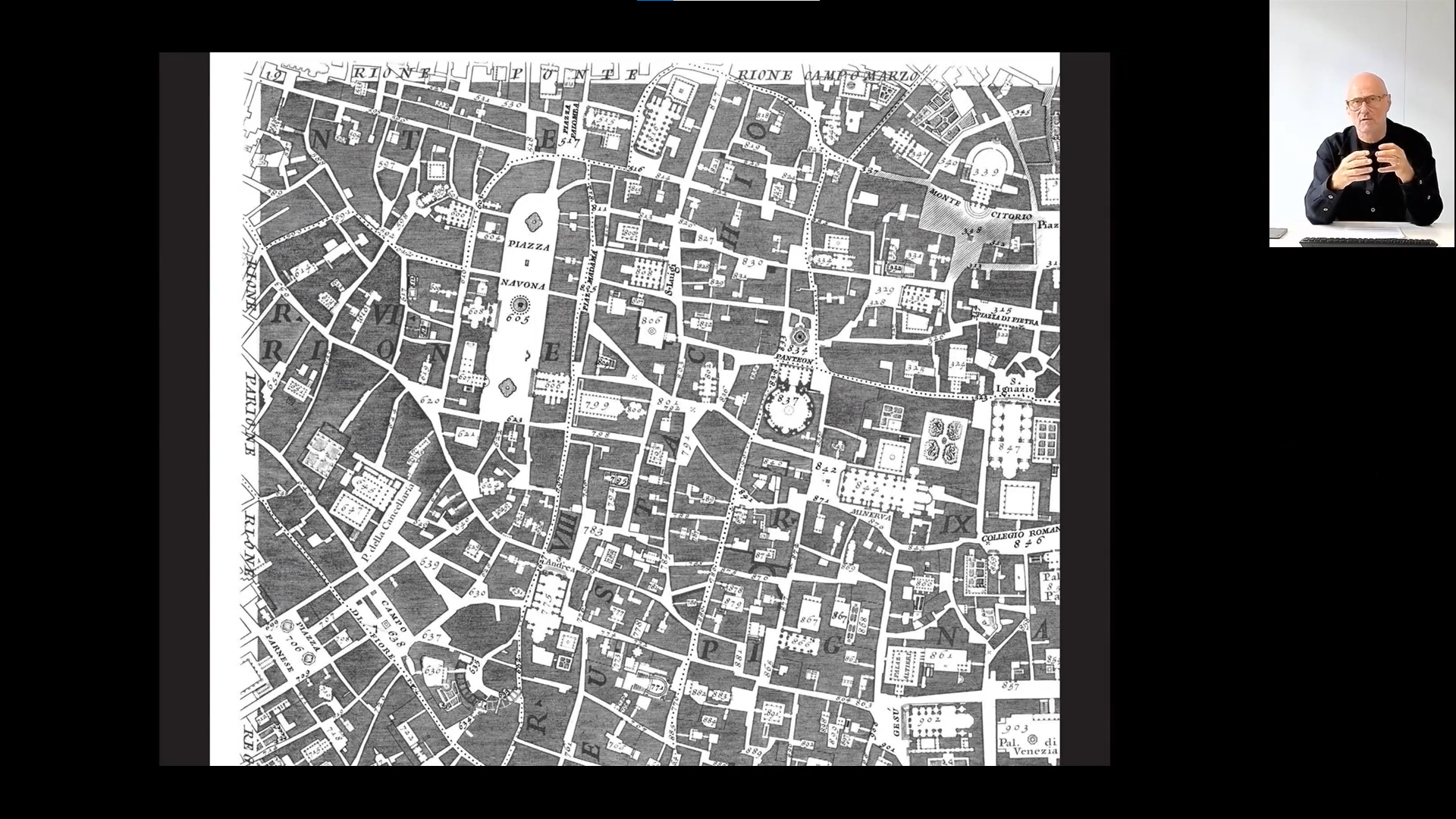
Nolli plan of Rome
We reconstruct and reinvent our cities, the greening of the city in London in 1910 was an idea of bringing rural idyll into the heart of the city. Now we established an idea in our cultures, but then part of a radical reinvention to do with restructuring the infrastructure and the facilities of the city. Talk about urban greening, historical cities like New York are bringing new spaces. This idea is moved from the greening of public space and the creation of new parks to the greening of our buildings themselves, not just in terms of carbon embodied operational, but in terms of actually kind of creating buildings almost forests.
Infrastructure to me is the greatest driver of the potential of the city to transform itself. Cities swallow districts, creative forces, tend to go to more affordable places in cities, infrastructure brings affordable places and connects them with other places. The infrastructure of the city above ground but equally importantly below ground is vital.
Historically, we’ve talked about density a lot. This is a mathematical model from the early twentieth century. I think we have a much more granular understanding of that which is part of a brave new world futurist model, but an endless review of density, air quality, pollution and light, is vital to create the creative city that people can enjoy healthily living in.

A mathematical model from the early twentieth century
This is Debord’s The Naked City. It is a great reminder of the fact that every city isn’t as in essence at its best a generous host to the imagination of those who occupy it. We will all construct a mental map of the districts we inhabit in the city, some way they pass through, some we may live in, some we may learn, some we may study, but they become an individual model of the city. A general city allows us all to construct those different models and to feel we have access to those different.
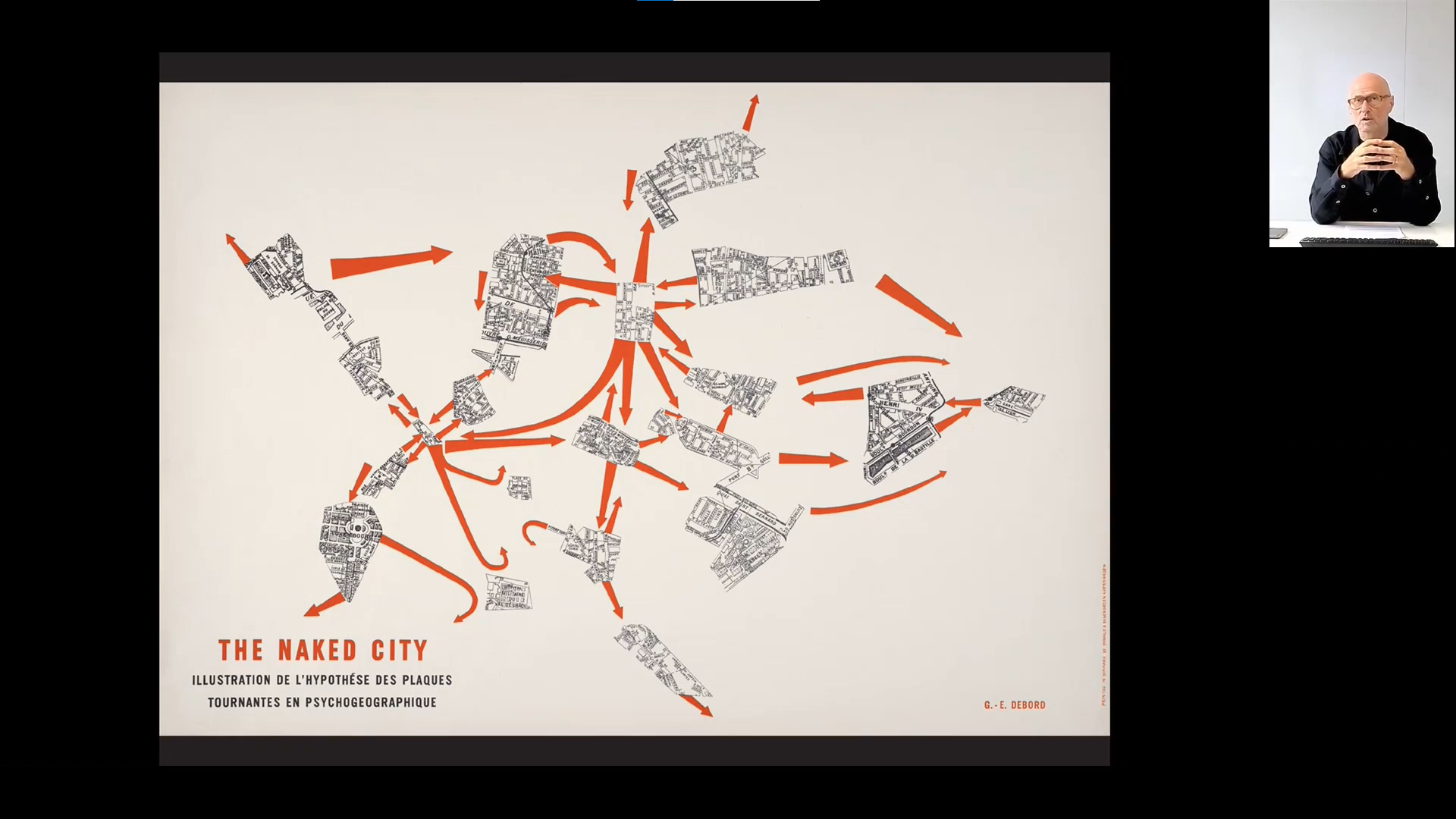
The Naked City by Guy Debord
This is a book London night and day, from a cartoonist Osbert Lancaster. It is an important story about entertainment and cultural world of London. It highlights the buildings work as receptacles for their uses. If you're thinking of a creative city, it’s the idea of different levels of affordability, different scales of space, different kinds of forms, places where people can live and learn, a kind of a rich hybrid of the institutions and business structures that make a city work. It's not about central business districts and modern cultural models. It’s a bottom-up activity with people taking advantage of situations rather than with some assistance from regulations or top-down drive to create something that government wants.
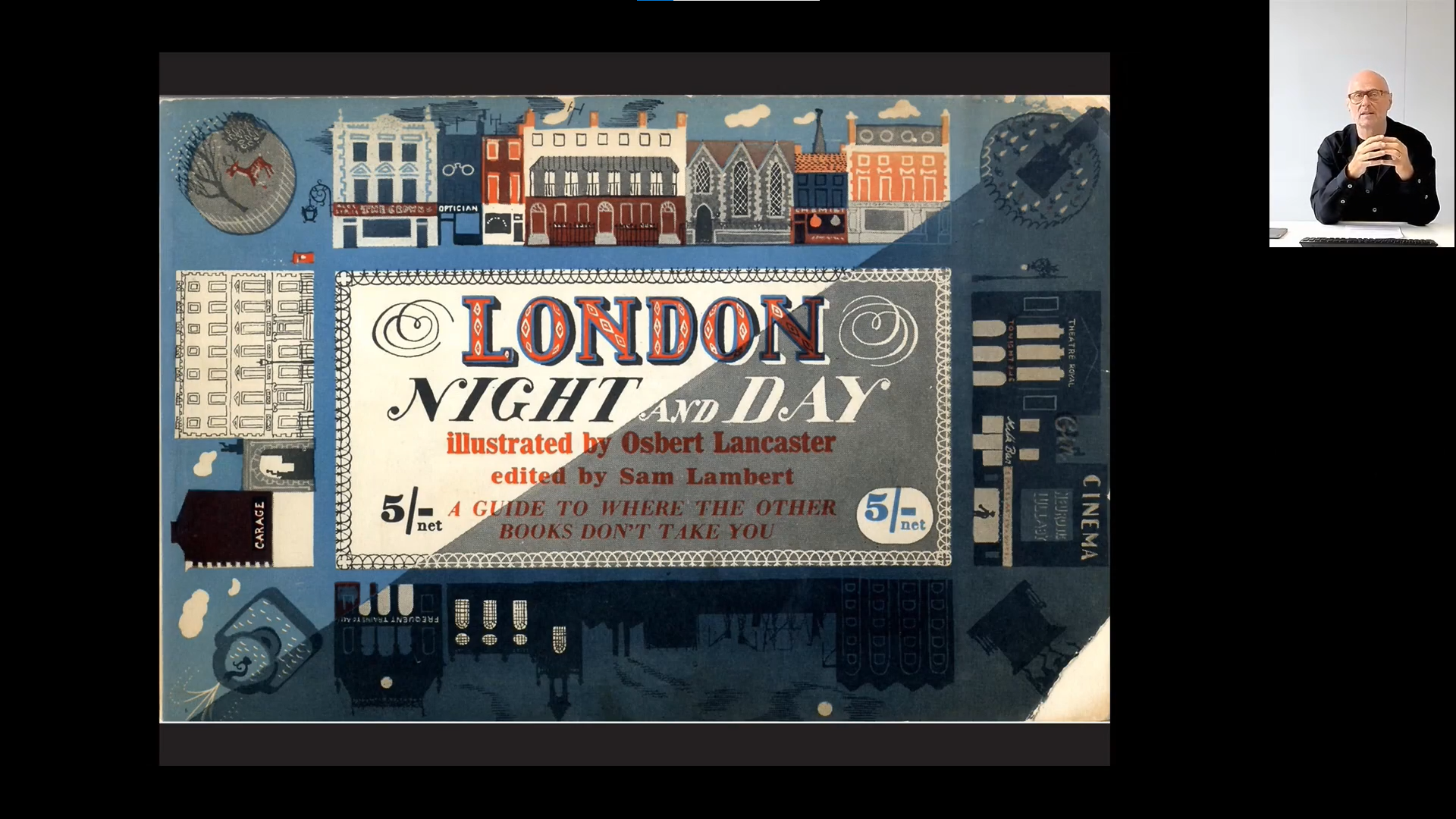
London night and day by Osbert Lancaster
Mies, talk about universally, on the left is the famous IIT building, on the right is the Segram building, but they are an idea of the 20th century vernacular that is a generous host to others to use for different functions. And buildings in a sense, our housing that universal use of addressing the city is they should offer a face, a door, a public room, or community.

IIT building and the Segram building by Ludwig Mies van der Rohe
This is the work of Giuseppe Terragni, Casa del Fascio, it highlights the import of an architectural organization to accommodate use over time. This was built for the fascist and became the home of communism. It’s now a museum in the city. The point is the building of the artificial qualities and character to allow others to adapt to their needs. Architecture is delight to encourage others and we are always playing in the building and the city between the specifics of our program and the generics needed by the future.
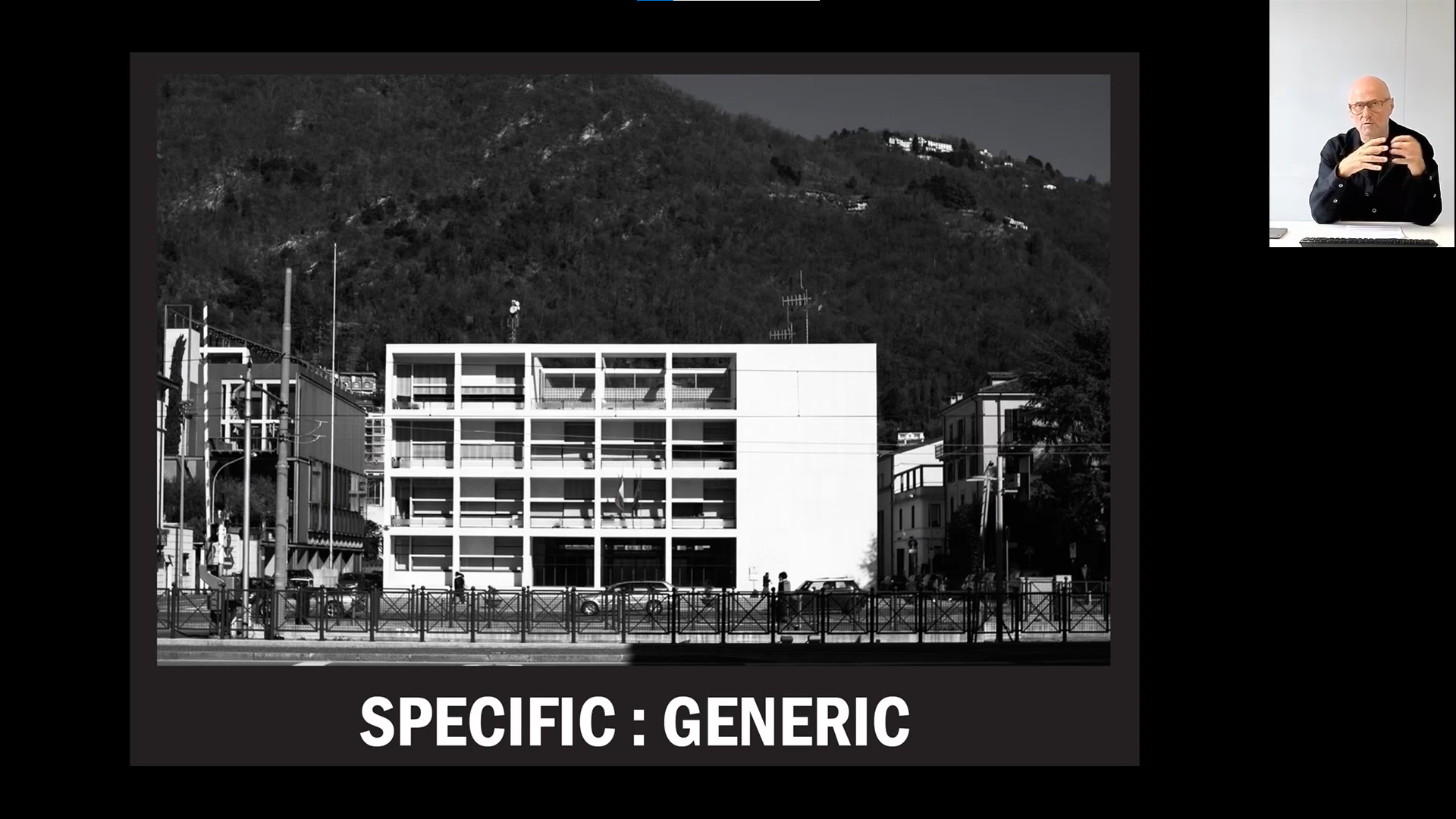
Casa del Fascio by Giuseppe Terragni
This is Jean Prouvé’s La Maison du Peuple in Clichy and again this is the tension between how we make our city. This is a delightful reorganized building where the community can engage and reform, but it’s also about making a rich mix from ready-made components. The industrialization of construction into the dispenser. Now we look forward the recycling of components and limiting not only ready-made but easily available.
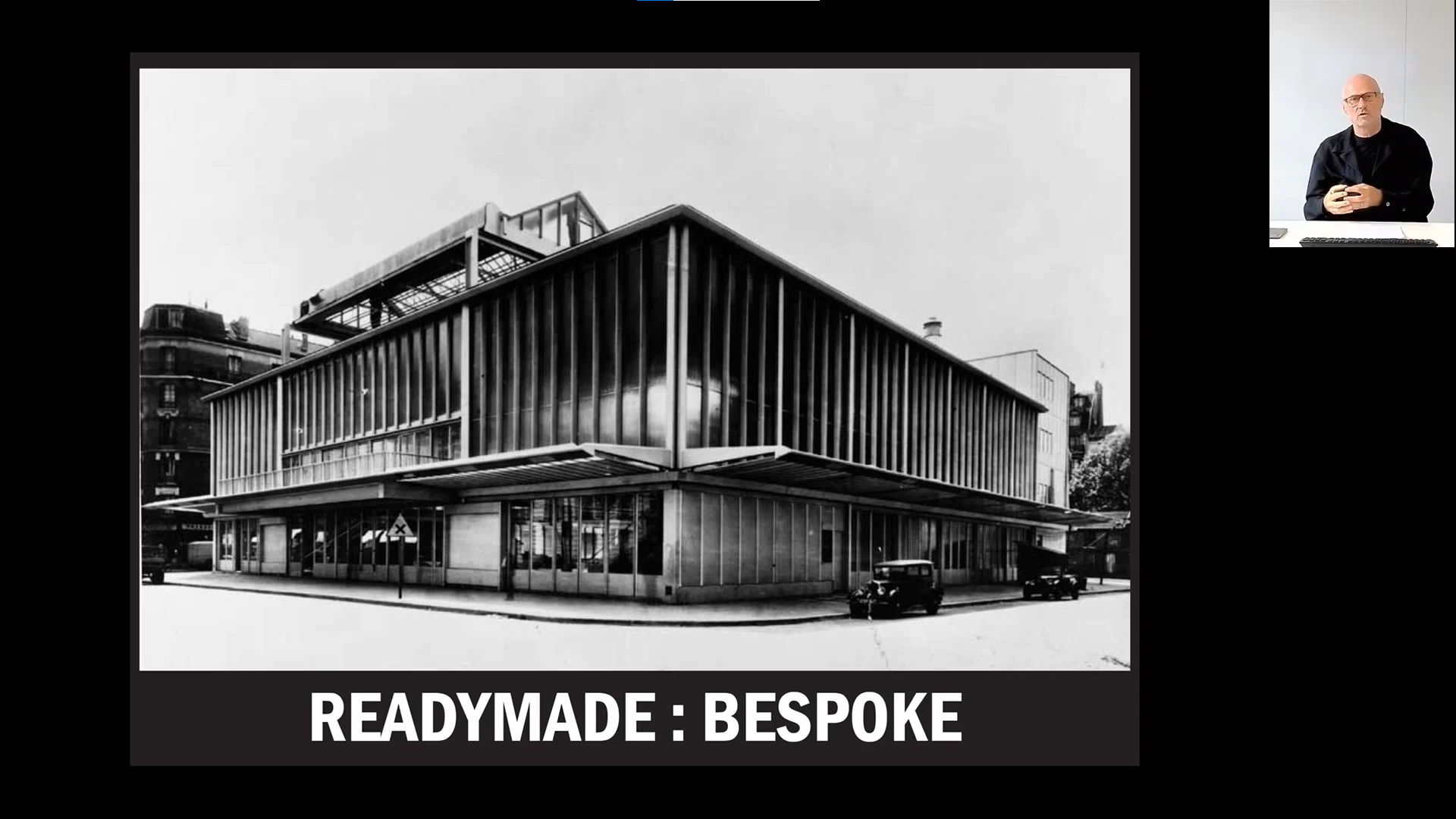
La Maison du Peuple by Jean Prouvé
When I think of a city, I think of public space as open and generous city rooms. In a sense, all good buildings and all good city quarters develop this characteristic of open accommodation of the diaspora of the city, bringing them together, and connecting them and allowing the chance encounter that leads to creativity.
We model the street within our buildings. This is the Bradbury building in Los Angeles. A brilliant a social space through which you move that leads all the criteria we talk about now. But even more importantly it shows this idea of buildings as community of users and an important idea of the future: buildings themselves as not modern cultural homes, but rich mixes of live, work and play.
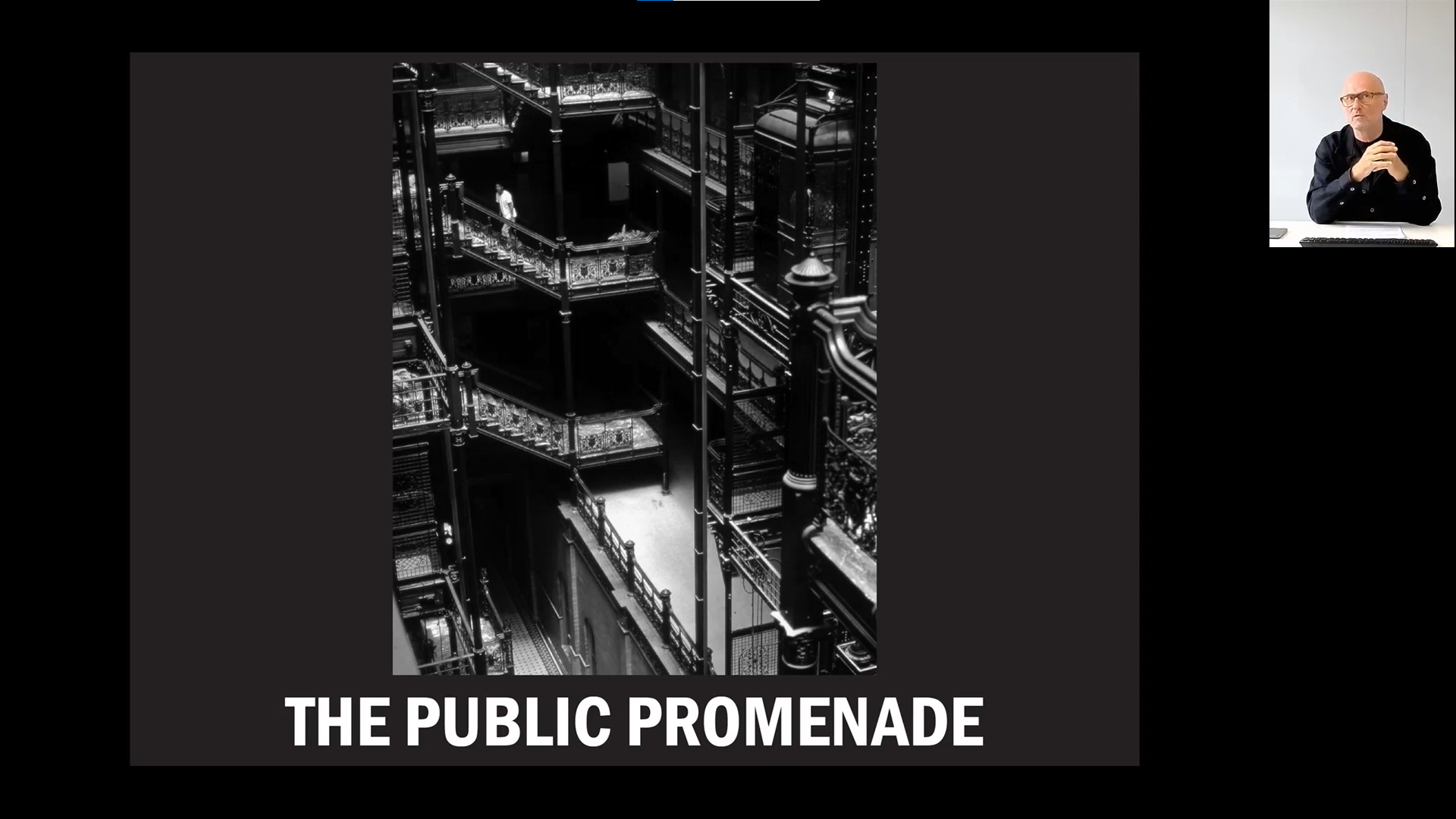
the Bradbury building in Los Angeles
The city and the building are the backdrop to the theatre of everyday life. The face of the buildings, the space of the city which is the most permanent becomes the social room for those who pass through it. And even if you don’t enter those buildings, the way they define a relationship between space and interior helps to describe the potential of the creative city as a social space, where you pause, you take time to think and encounter others.
So as a practice, we talk about the city and the building as the infrastructure, but in the case of the building it’s the long-term construction of frame in the case of the city, it’s street and infrastructure, and public transport system. Then there are stage sets these the interim projects of use which will come and go. I'm trying to highlight in a very good building with generous volumes and light and in both cases, people want to stay and adapt and use that space. And then there are the props that idea that within the architecture within the city, there is the opportunity for the individual to adapt their day-to-day life and engage with the environment around them.
We talk a lot now about embodied carbon and operational carbon and that is an absolutely vital challenge. But it’s a challenge which kind of references the same conversation? If half the carbon of a building of over 60 years is anticipated to be used up to the completion of that building. It suggests to me not only should be making buildings that use less carbon in their instruction as well as the operation, for buildings that do not need excessive fit out, buildings that are robust, theaters as backdrop.
So we’re on a rapid journey. We are now thinking about embodied carbon and adaptation use, and operational carbon over time. These drivers are very important to our conversation, but we must never forget that it is the lowest carbon city in the world where people don’t want to live is a carbon failure. We have responsibility to work with what we have, not just in terms of our building’s recycling, reusing and reinventing them, but recycling reusing and reinventing our cities because they have the richness, they are the collage.
Cedric Price talked about the ancient fried and scrambled egg as models of the city. I think we should always keep these things as simple as we can. Because the program of construction and infrastructure underfunding and the governance of that will create enough complexity.

Cedric Price propositions: The city as an egg
Manhattan is a brilliant city. London is a city of incidence. Both our global creative cities like Shanghai. London survives on a much different scale because of its broken and multiple clashing plans creates edible map of very different parts of the city for people to gravitate to. It is the polar opposites but both are successful.
We are in a race against the time, the climate challenge and with a race you have a single focus. But we can’t afford single focus, we need to think broadly about rethinking the city and creating the creative city that serves the inhabitants into the next century. This is an image of the transport bridge at Marseille, but I would say it is very much the future, something that we are reaching out to and always will be. But it’s not about designing bridges, it’s about the journey and how best to get there. Thank you.

Transport bridge at Marseille